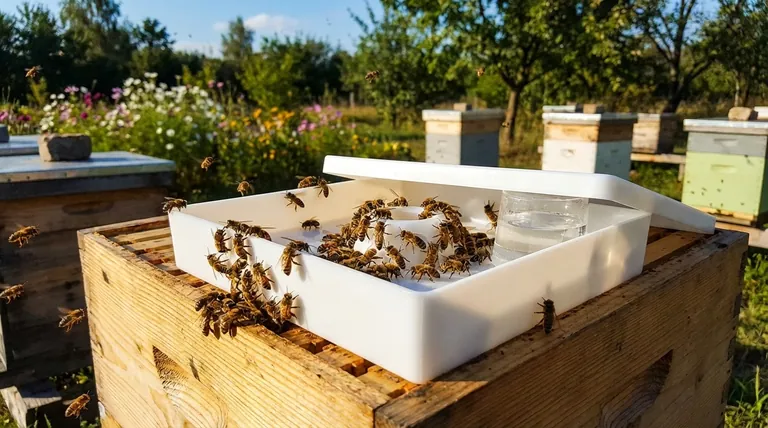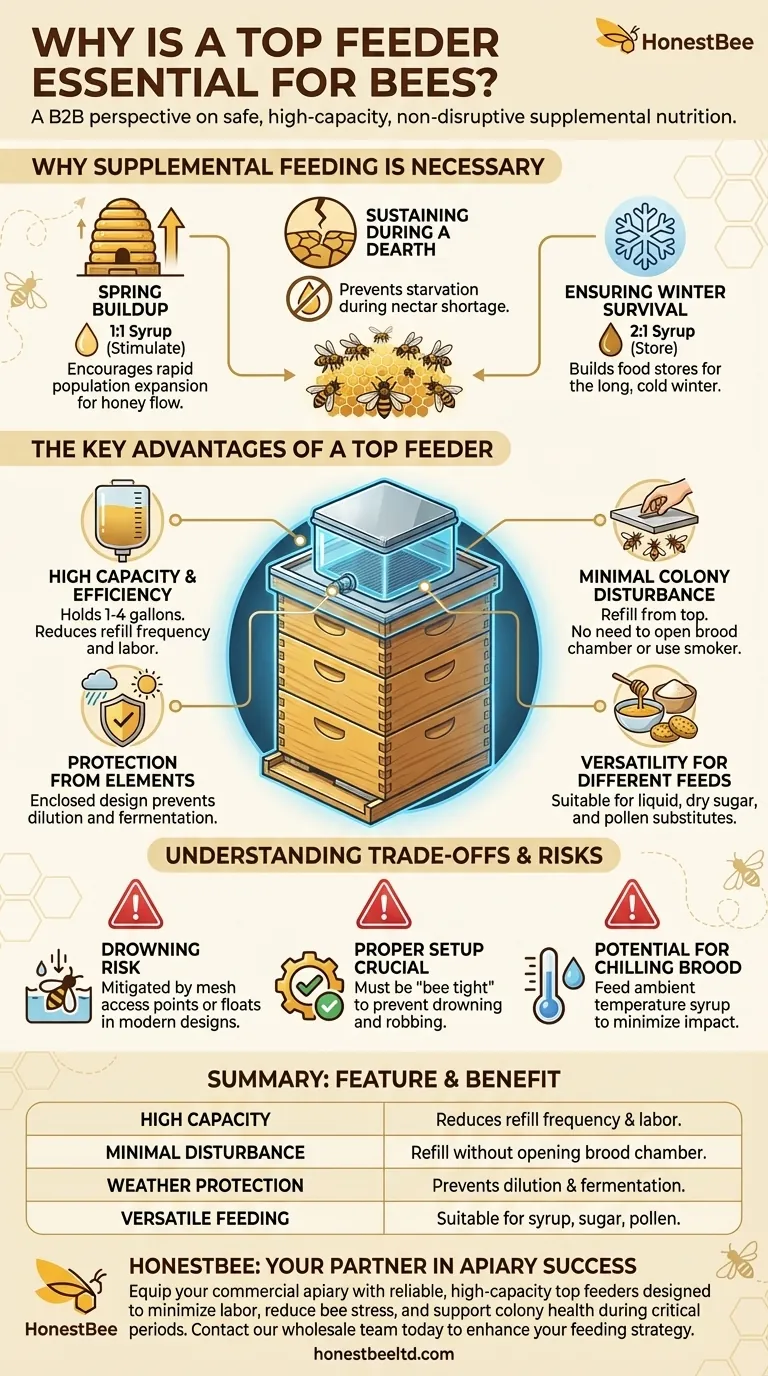At its core, a top feeder is considered essential because it provides a safe, high-capacity, and non-disruptive way to deliver supplemental nutrition to a bee colony. Placed on the uppermost box of the hive, it protects feed from the environment and allows beekeepers to refill it with minimal disturbance to the bees below, making it a reliable tool for critical feeding periods like spring buildup and fall preparation.
A beekeeper's primary goal is to ensure a colony has the resources to thrive. The top feeder is a critical tool for this, not just for convenience, but because it minimizes stress on the colony during the vulnerable times when it needs help the most.

Why Supplemental Feeding is Necessary
Before understanding the feeder itself, it's crucial to know why a colony might need supplemental feeding in the first place. Bees are self-sufficient under ideal conditions, but modern beekeeping often requires intervention.
Promoting Spring Buildup
In early spring, a beekeeper might feed a 1:1 sugar-to-water syrup to simulate a nectar flow. This encourages the queen to lay eggs and rapidly expand the colony's population in preparation for the main honey flow.
Sustaining During a Dearth
A "dearth" is a period with a shortage of natural nectar, often occurring in the heat of mid-summer. Feeding during this time can prevent the colony from consuming its winter stores prematurely or starving.
Ensuring Winter Survival
This is the most critical feeding period. In the fall, beekeepers feed a thick 2:1 sugar-to-water syrup. The bees process this into stored honey, ensuring they have enough food to survive the long, cold winter months when foraging is impossible.
The Key Advantages of a Top Feeder
While other feeders exist, the top feeder design offers distinct advantages that make it a preferred choice for many beekeepers, especially for large-scale feeding.
High Capacity and Efficiency
Top feeders hold a large volume of syrup, often one to four gallons. This means a beekeeper only needs to refill them every week or two, drastically reducing labor and the frequency of hive visits.
Minimal Colony Disturbance
This is perhaps the most significant benefit. Because the feeder sits on top of the hive, you can check and refill it simply by removing the outer cover. There is no need to open the main brood chamber, use a smoker, or otherwise disturb the bees, which reduces stress on the colony and the risk of stings for the beekeeper.
Protection from the Elements
The enclosed design shields the syrup from rain, which would dilute it, and sun, which can cause it to ferment. It also prevents debris from contaminating the food source.
Versatility for Different Feeds
While primarily used for liquid syrup, top feeders can also be used to provide dry sugar during the winter. This "winter candy" method provides emergency food without introducing excess moisture into the hive. Some beekeepers also pair feed with pollen substitutes in the feeder to boost brood development.
Understanding the Trade-offs and Risks
No piece of equipment is perfect. An objective assessment requires understanding the potential downsides of top feeders.
The Primary Risk: Drowning
The most cited concern with top feeders is the risk of bees drowning in the syrup. Some models have large, open reservoirs. However, modern designs mitigate this with mesh-covered access points or floats that allow bees to drink safely without falling in.
Proper Setup is Crucial
To prevent drowning and robbing from other hives, the feeder must be set up correctly. This means ensuring any access screens are "bee tight" and that the feeder is enclosed by an empty hive box to seal it off from outside access.
Potential for Chilling the Brood
Placing a large volume of cold syrup directly above the bee cluster in cool weather can potentially chill the brood nest below. It's often wise to feed syrup at ambient temperature to minimize this effect.
Making the Right Choice for Your Goal
Using a top feeder correctly depends entirely on your colony's needs and the time of year.
- If your primary focus is rapid spring growth: Use a top feeder to provide 1:1 syrup to stimulate egg-laying and population expansion.
- If your primary focus is preparing for winter: Use a top feeder to deliver large quantities of 2:1 syrup in the fall, ensuring the colony has enough stored food to survive.
- If your primary focus is emergency winter feeding: Use a top feeder to provide dry sugar, which gives the bees calories without adding harmful moisture to the hive.
- If your primary focus is minimizing hive stress: A top feeder is the ideal choice for any feeding scenario, as it requires the least invasive interaction with the colony.
Ultimately, mastering the top feeder empowers you to act as a responsible steward for your bees, providing critical support exactly when they need it.
Summary Table:
| Feature | Benefit |
|---|---|
| High Capacity | Holds 1-4 gallons, reducing refill frequency and labor. |
| Minimal Disturbance | Refill from the top without opening the brood chamber. |
| Weather Protection | Enclosed design prevents rain dilution and sun fermentation. |
| Versatile Feeding | Suitable for liquid syrup, dry sugar, and pollen substitutes. |
Equip your apiary with reliable, high-capacity top feeders from HONESTBEE.
As a trusted supplier for commercial apiaries and beekeeping equipment distributors, we understand that efficient feeding is critical for colony health and your operational success. Our top feeders are designed to minimize labor, reduce bee stress, and support your colonies during spring buildup and winter preparation.
Ready to enhance your feeding strategy? Contact our wholesale team today to discuss your needs and discover how HONESTBEE's equipment can support your beekeeping goals.
Visual Guide

Related Products
- HONESTBEE Professional Hive Top Bee Feeder Feeding Solution
- Professional Hive Top Bee Feeder for Beekeeping
- HONESTBEE Round Hive Top Bee Feeder for Syrup
- HONESTBEE Entrance Bee Feeder Professional Hive Nutrition Solution for Beekeeping
- Professional Hive Front Entrance Bee Feeder
People Also Ask
- Do I need an inner cover with a hive top feeder? Optimize Your Hive Setup for Healthy Bees
- What is the best way to top feed bees? A Safe, High-Volume Feeding Solution for Your Apiary
- How do I keep bees from drowning in my top feeder? Ensure Safe Feeding for Your Hive
- What safety features are included in top feeders? A Guide to Drowning Prevention and Hive Safety
- What are the advantages of hive top feeders? Maximize Feeding Efficiency for Your Apiary



















